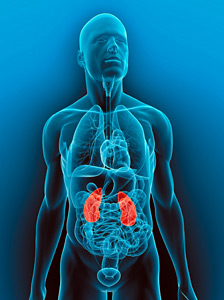Kidney stones are one of the most common disorders of the urinary tract, reported to affect about 12 percent of men and 5 percent of women over their lifetime.
In the case of gallbladder stones, a low-fat, low-cholesterol diet is advisable to prevent gallstone formation, but some susceptible individuals may develop gallstones even when consuming a healthy diet.
Patients who develop kidney or gallbladder stones may wish to take a combination supplement containing ingredients shown to help dissolve stones and prevent their recurrence. The best evidence in this regard suggests supplementation with the herb Chanca piedra, vitamin B6 and magnesium.
 Chanca piedra is a popular South American herb that has been used to dissolve and eliminate kidney stones and gallbladder stones. The English translation for Chanca piedra is "stone crusher." Recent scientific evidence has provided solid evidence of this therapeutic effect. A 2006 Brazilian study showed that the therapeutic effect of Chanca piedra may be due to its ability to modify the shape and texture of stones (calculi) to a smoother and more fragile form, which would allow for easier elimination and/or dissolution of the stones.1
Chanca piedra is a popular South American herb that has been used to dissolve and eliminate kidney stones and gallbladder stones. The English translation for Chanca piedra is "stone crusher." Recent scientific evidence has provided solid evidence of this therapeutic effect. A 2006 Brazilian study showed that the therapeutic effect of Chanca piedra may be due to its ability to modify the shape and texture of stones (calculi) to a smoother and more fragile form, which would allow for easier elimination and/or dissolution of the stones.1
Another study demonstrated that Chanca piedra has an inhibitory effect on crystal growth and aggregation in human urine, which may inhibit stone formation, acting as an important part of a prevention strategy in those with a past history of kidney stones.2
A 2006 study involving 150 patients with kidney stones tested the efficacy of Chanca piedra supplementation in patients administered shock-wave therapy. Shock-wave therapy (delivered from outside the body) breaks down stones to facilitate their elimination. Upon completion of this therapy, approximately half of the patients were given 2 grams of Chanca piedra every day for 30 days. The remainder of the group did not take the herb and acted as controls. Stone clearance was assessed after 30, 60, 90 and 180 days by abdominal X-ray and ultrasound scan. The herb-supplemented patients were shown to have a stone-free rate 10-23 percent higher than the control group.3
As an aside, Chanca piedra has also been shown to increase the urinary excretion of uric acid; thus, it may also be helpful in the management of gout and hyperuricemia.4
Vitamin B6 and magnesium: Supplementation with vitamin B6 and magnesium has also shown positive effects in preventing the recurrence of kidney stones. In a landmark study, 149 patients with longstanding recurrent kidney stones (calcium oxalate and mixed calcium oxalate/calcium phosphate) received 100 mg of magnesium three times a day and 10 mg of pyridoxine (vitamin B6) once a day for 4.5-6 years. The mean rate of stone formation fell by 92.3 percent, from 1.3 stones per patient per year prior to the study to 0.10 stones per patient per year during the study. No significant side effects occurred.5 Other studies have shown that using various forms of magnesium alone can prevent the recurrence of kidney stones in previous sufferers.6-7
Based on the research summarized above, in patients with existing kidney or gallbladder stones and no medical treatment currently planned, I suggest patients make appropriate dietary changes, drink more water (for kidney stones) and take a supplement twice per day containing therapeutic dosages of Chanca piedra, vitamin B6 and magnesium.
References
- Barros ME, Schor N, Boim MA. Effects of an aqueous extract from Phyllantus niruri on calcium oxalate crystallization in vitro. Urol Res, 2003 Feb;30(6):374-9.
- Barros ME, Lima R, Mercuri LP, Matos JR, Schor N, Boim MA. Effect of extract of Phyllanthus niruri on crystal deposition in experimental urolithiasis. Urol Res, 2006 Dec;34(6):351-7.
- Micali S, Sihinolfi MC, Celia A, De Stefani S, Grande M, Cicero AF, Bianchi G. Can Phyllanthus niruri affect the efficacy of extracorporeal shock wave lithotripsy for renal stones? A randomized, prospective, long-term study. J Urol, 2006 Sep;176(3):1020-2.
- Murugaiyah V, Chan KL. Antihyperuricemic lignans from the leaves of Phyllanthus niruri. Planta Med, 2006 Nov;72(14):1262-7.
- Prien EL Sr, Gershoff SN. Magnesium oxide-pyridoxine therapy for recurrent calcium oxalate calculi. J Urol, 1974;112:509-512.
- Ettinger B, et al. Potassium-magnesium citrate is an effective prophylaxis against recurrent calcium oxalate nephrolithiasis. Jrn Urol, 1997 Dec;158(6):2069-2073.
- Massey L. Magnesium therapy for nephrolithiasis. Mag Res, 2005 Jun;18(2):123-6.
Click here for more information about James P. Meschino, DC, MS.





